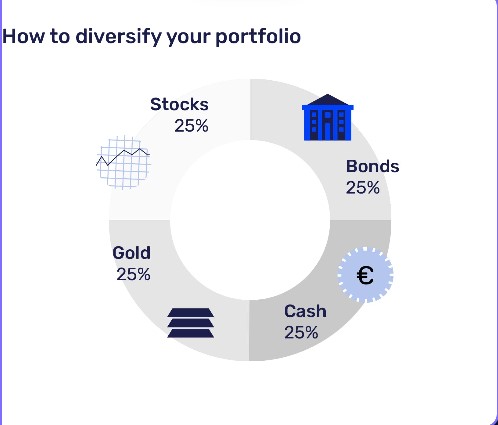
Be a Better Investor: Diversification
By Article Posted by Staff Contributor
The estimated reading time for this post is 247 seconds
Diversification is a fundamental concept in investment management that aims to minimize risk and maximize returns by spreading investments across different asset classes, industries/sectors, and geographical regions.
This strategy helps investors reduce their exposure to individual risks and achieve a more balanced and resilient portfolio. This article will explore the concept of diversification, its strategy, and its implications for retail investors.
We will also examine the pros and cons of diversification and differentiate between diversifiable and non-diversifiable risks.
What Is Diversification?
Diversification is an investment strategy that involves allocating funds across various assets to reduce exposure to any single investment. The underlying principle is based on the notion that different assets tend to have varying correlations.
By investing in a mix of assets with low correlations, investors aim to mitigate the impact of adverse events affecting any particular investment.
Understanding Diversification
Diversification spreads investments across different asset classes, such as stocks, bonds, real estate, commodities, and alternative investments.
It also involves investing in various industries or sectors within those asset classes. The rationale behind this approach is that different assets and sectors tend to perform differently under various market conditions.
When one asset class or sector underperforms, others may compensate and provide positive returns, minimizing the overall portfolio risk.
Diversification Strategies
Asset Class Diversification
Investors can diversify across asset classes, such as equities, fixed income, and commodities. Each asset class has unique risk and return characteristics.
By allocating investments across these classes, investors can benefit from the uncorrelated performance of different portfolio assets. For instance, during an economic downturn, bonds may provide stability while equities face a decline.
Industry/Sector Diversification
Investors can diversify within each asset class by allocating investments across different industries or sectors.
For example, investors can spread their investments within the equity market across sectors like technology, healthcare, finance, and energy. By doing so, they can reduce the risk associated with being overly concentrated in a single industry, such as suffering significant losses if that sector experiences a downturn.
Diversification and the Retail Investor
Diversification is equally relevant for retail investors as it is for institutional investors.
Retail investors often have limited resources and may need access to sophisticated investment options. However, they can still achieve diversification through mutual funds, exchange-traded funds (ETFs), or target-date retirement funds.
These investment vehicles pool together funds from multiple investors and diversify across various asset classes and sectors, making diversification accessible to retail investors.
Pros of Diversification
Risk Reduction
Diversification helps reduce the impact of individual investment losses by spreading risk across different assets or sectors. When one investment performs poorly, others may counterbalance those losses, mitigating overall portfolio risk.
Potential for Higher Returns
By diversifying, investors can capture positive returns from different assets or sectors that outperform during specific market conditions. This can enhance portfolio performance and generate higher returns over the long term.
Protection against Uncertainty
Diversification can shield investors from unforeseen events or market shocks affecting specific investments or sectors. It provides a safety net by avoiding overexposure to a single asset, reducing the portfolio’s vulnerability.
Cons of Diversification
Potential for Lower Returns
Diversification inherently means spreading investments across multiple assets, which could limit the potential for outsized gains.
A diversified portfolio may not fully capture those high returns if a particular investment performs exceptionally well.
Complexity and Increased Costs
Building and maintaining a diversified portfolio can be complex and time-consuming, especially for individual investors.
It requires research, analysis, and ongoing monitoring of various investments. Moreover, diversification can increase transaction costs and management fees, impacting overall returns.
Diversifiable vs. Non-Diversifiable Risk
Diversifiable, unsystematic, or idiosyncratic risks are the portion of an investment’s risk that can be eliminated through diversification.
This risk is specific to individual securities or companies and includes factors such as management decisions, product performance, or regulatory changes. By holding a diversified portfolio, investors can reduce diversifiable risk.
Non-diversifiable or systematic risk is inherent to the overall market or economy and cannot be eliminated through diversification.
Factors such as interest rate fluctuations, geopolitical events, or broad economic trends impact all investments to some extent. Examples of non-diversifiable risks include recessions, inflation, or sudden market downturns.
Asset allocation and risk management strategies are the only way to manage non-diversifiable risk.
Conclusion
Diversification is a crucial strategy for managing risk and maximizing returns in investment portfolios.
By spreading investments across different asset classes, industries/sectors, and regions, investors can reduce the impact of individual risks and increase the potential for long-term gains.
Retail investors can achieve diversification through investment vehicles like mutual funds or ETFs.
While diversification offers numerous benefits, investors should consider the potential trade-offs, such as limited returns and increased complexity.
Moreover, it is essential to distinguish between diversifiable and non-diversifiable risks to implement effective risk management strategies.
Finding the right balance between diversification and concentration based on individual investment goals and risk tolerance is critical to successful portfolio management.
RELATED ARTICLES
How Much Do the Holidays Cost Middle-Class Americans?
The estimated reading time for this post is 274 seconds You already know the punchline: they cost more than we planned—financially and emotionally. Between Halloween, Thanksgiving, Christmas, and everything in between, too many middle-class families overspend, carry a balance, and...
Black Friday & Cyber Monday: Deal or Theater?
The estimated reading time for this post is 221 seconds You don’t need more “doorbusters.” You need a plan that keeps you out of the interest trap. Real deals exist, but most of what you’ll see is performance designed to...
Leave Comment
Cancel reply

Government Shutdown Leaves Millions Unpaid. Here’s How Banks Are Helping (Right Now)

DIY Retirement: How Workers Became the Risk Bearers

Why Saving Is So Hard for Middle-Class Americans (and the 12-Month Plan That Works)
Gig Economy
American Middle Class / Nov 02, 2025
Government Shutdown Leaves Millions Unpaid. Here’s How Banks Are Helping (Right Now)
The estimated reading time for this post is 518 seconds Reality Check Your paycheck stops; your life doesn’t. It’s Day 31 of the shutdown. Rent is...
By Article Posted by Staff Contributor
American Middle Class / Nov 01, 2025
DIY Retirement: How Workers Became the Risk Bearers
The estimated reading time for this post is 299 seconds The Plain‑English Take There was a time when a steady paycheck, a pension, and a gold...
By FMC Editorial Team
American Middle Class / Oct 31, 2025
Why Saving Is So Hard for Middle-Class Americans (and the 12-Month Plan That Works)
The estimated reading time for this post is 215 seconds Most middle-class households aren’t “bad with money.” They’re paying a quiet tax in fixed costs and...
By Article Posted by Staff Contributor
American Middle Class / Oct 31, 2025
Annual Reminder: Review Your Beneficiaries (The 15-Minute Wealth Check)
The estimated reading time for this post is 302 seconds Why this matters (more than your will) A once-a-year habit that keeps your intentions aligned with...
By Article Posted by Staff Contributor
American Middle Class / Oct 29, 2025
A Plan to Grow Your FICO® Score (Without the Gimmicks)
The estimated reading time for this post is 599 seconds Reality Check You don’t need another lecture. You need a plan that works in the middle...
By Article Posted by Staff Contributor
American Middle Class / Oct 29, 2025
Estate Planning for Your Digital Assets
The estimated reading time for this post is 489 seconds You’ve got a will for the house and the car. Good. But what about the stuff...
By Article Posted by Staff Contributor
American Middle Class / Oct 27, 2025
Food Inflation vs. Holiday Menus: Feast Without the Financial Hangover
The estimated reading time for this post is 185 seconds You can feed a full house without making your card issuer fat and happy. The trick...
By Article Posted by Staff Contributor
American Middle Class / Oct 27, 2025
The Middle-Class Holiday Travel Playbook (Thanksgiving & December)
The estimated reading time for this post is 263 seconds Travel is where good budgets go to die. Prices spike, emotions run hot, and suddenly you’re...
By Article Posted by Staff Contributor
American Middle Class / Oct 26, 2025
How Much Do the Holidays Cost Middle-Class Americans?
The estimated reading time for this post is 274 seconds You already know the punchline: they cost more than we planned—financially and emotionally. Between Halloween, Thanksgiving,...
By Article Posted by Staff Contributor
American Middle Class / Oct 26, 2025
Black Friday & Cyber Monday: Deal or Theater?
The estimated reading time for this post is 221 seconds You don’t need more “doorbusters.” You need a plan that keeps you out of the interest...
By Article Posted by Staff Contributor
Latest Reviews
American Middle Class / Nov 02, 2025
Government Shutdown Leaves Millions Unpaid. Here’s How Banks Are Helping (Right Now)
The estimated reading time for this post is 518 seconds Reality Check Your paycheck stops;...
American Middle Class / Nov 01, 2025
DIY Retirement: How Workers Became the Risk Bearers
The estimated reading time for this post is 299 seconds The Plain‑English Take There was...
American Middle Class / Oct 31, 2025
Why Saving Is So Hard for Middle-Class Americans (and the 12-Month Plan That Works)
The estimated reading time for this post is 215 seconds Most middle-class households aren’t “bad...



